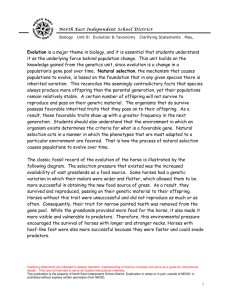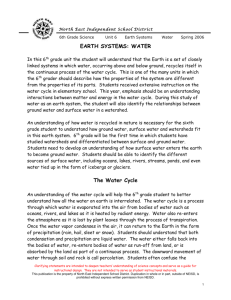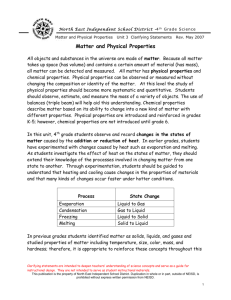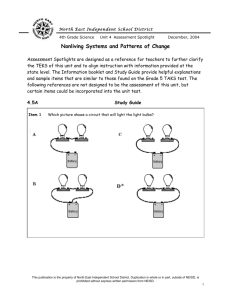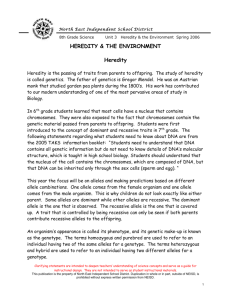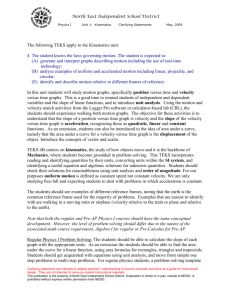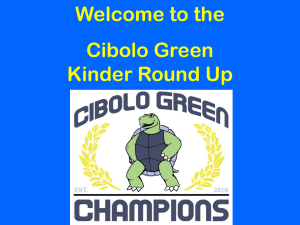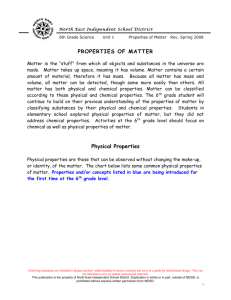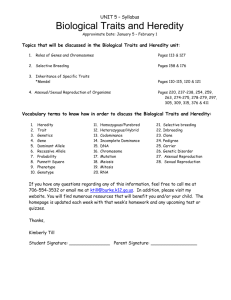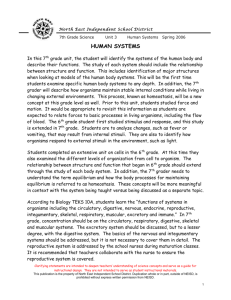Cells & Heredity - North East Independent School District
advertisement
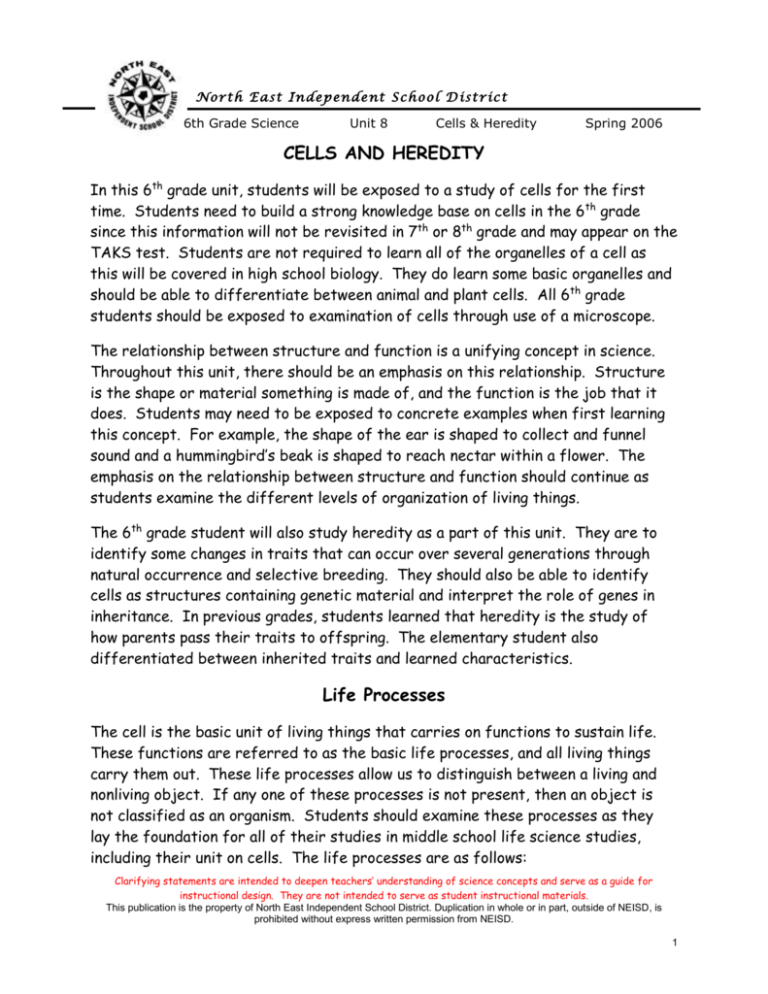
N o r t h E a st I n d ep en d e nt S c h o o l D i st ric t 6th Grade Science Unit 8 Cells & Heredity Spring 2006 CELLS AND HEREDITY In this 6th grade unit, students will be exposed to a study of cells for the first time. Students need to build a strong knowledge base on cells in the 6th grade since this information will not be revisited in 7th or 8th grade and may appear on the TAKS test. Students are not required to learn all of the organelles of a cell as this will be covered in high school biology. They do learn some basic organelles and should be able to differentiate between animal and plant cells. All 6th grade students should be exposed to examination of cells through use of a microscope. The relationship between structure and function is a unifying concept in science. Throughout this unit, there should be an emphasis on this relationship. Structure is the shape or material something is made of, and the function is the job that it does. Students may need to be exposed to concrete examples when first learning this concept. For example, the shape of the ear is shaped to collect and funnel sound and a hummingbird’s beak is shaped to reach nectar within a flower. The emphasis on the relationship between structure and function should continue as students examine the different levels of organization of living things. The 6th grade student will also study heredity as a part of this unit. They are to identify some changes in traits that can occur over several generations through natural occurrence and selective breeding. They should also be able to identify cells as structures containing genetic material and interpret the role of genes in inheritance. In previous grades, students learned that heredity is the study of how parents pass their traits to offspring. The elementary student also differentiated between inherited traits and learned characteristics. Life Processes The cell is the basic unit of living things that carries on functions to sustain life. These functions are referred to as the basic life processes, and all living things carry them out. These life processes allow us to distinguish between a living and nonliving object. If any one of these processes is not present, then an object is not classified as an organism. Students should examine these processes as they lay the foundation for all of their studies in middle school life science studies, including their unit on cells. The life processes are as follows: Clarifying statements are intended to deepen teachers’ understanding of science concepts and serve as a guide for instructional design. They are not intended to serve as student instructional materials. This publication is the property of North East Independent School District. Duplication in whole or in part, outside of NEISD, is prohibited without express written permission from NEISD. 1 N o r t h E a st I n d ep en d e nt S c h o o l D i st ric t 6th Grade Science Unit 8 Cells & Heredity Spring 2006 All living things are made of one or more cells. All living things obtain and use energy. All living things grow and develop. All living things reproduce. All living things respond to their environment. Cells Cells were not discovered until the 1600’s because they were too small to be seen, and the microscope had not yet been invented. Robert Hooke was the first person to observe cells, examining cork from a tree. The cork looked like it was made up of tiny rooms, or cells. In Latin, cell means “tiny room.” Students will be exposed to many different representations, pictures, or diagrams of cells throughout life science studies. This provides the teacher with an excellent opportunity to discuss the different models and identify their limitations. Many teachers also utilize the “cell as a factory” conceptual model to assist their students in understanding the functions of the various organelles. All living things are composed of at least one cell. Organisms made up of only one cell are referred to as unicellular. Organisms made up of many cells are called multicellular. Large organisms, such as humans, have billions of cells. Students might think that most organisms on Earth are multicellular. In fact, the majority of organisms are microscopic, single-celled organisms such as bacteria, algae, certain fungi, and protozoa. Students should understand that even unicellular organisms carry out all of the life processes. They have structures for obtaining food, movement to respond to their Clarifying statements are intended to deepen teachers’ understanding of science concepts and serve as a guide for instructional design. They are not intended to serve as student instructional materials. This publication is the property of North East Independent School District. Duplication in whole or in part, outside of NEISD, is prohibited without express written permission from NEISD. 2 N o r t h E a st I n d ep en d e nt S c h o o l D i st ric t 6th Grade Science Unit 8 Cells & Heredity Spring 2006 environment, etc. The following illustrates the cillia and flagella for mobility that assist many unicellular organisms in their daily functions, such as obtaining food: Cells grow and divide, producing more cells. Organisms grow by increasing the number of cells, not by one cell getting larger. Cells take in nutrients that are used to provide the energy required for cells to accomplish their various functions. Cells are made of parts, collectively referred to as organelles, each of which provides an important function within the cell. The 6th grade student should be familiar with the cell theory which summarizes these concepts. The Cell Theory has 3 components as follows: 1. All organisms are made of cells 2. The cell is the basic unit of life. 3. All cells come from other cells. The three main parts of any cell are the nucleus, cytoplasm, and cell membrane. These organelles are listed, along with some others, in the chart that follows. The chart provides the basic information 6th grade students should master when learning about the structure and function of cells. The chart also provides the necessary information to differentiate between animal and plant cells. Structure Animal vs. Plant nucleus usually found near cell center both cell membrane thin; surrounds cell both cytoplasm watery gel throughout cell both Function command center holds chromosomes controls what enters and leaves the cell holds all of the other parts of the cell Clarifying statements are intended to deepen teachers’ understanding of science concepts and serve as a guide for instructional design. They are not intended to serve as student instructional materials. This publication is the property of North East Independent School District. Duplication in whole or in part, outside of NEISD, is prohibited without express written permission from NEISD. 3 N o r t h E a st I n d ep en d e nt S c h o o l D i st ric t 6th Grade Science Unit 8 Structure mitochondrion vacuole chloroplast cell wall membrane-bound organelle found in the cytoplasm 1, large in plant cell several, small in animal cell green, contains chlorophyll thick, tough layer; surrounds cell Cells & Heredity Animal vs. Plant Spring 2006 Function both provides the energy needed for cell activities both for storage of food or water plant plant chlorophyll traps sunlight for photosynthesis provides support and protection Students should have the opportunity to examine a variety of different animal and plant cell models. The illustrations that follow are very basic and this often creates the misconception among students that all plant or animal cells look alike. Students should understand cells come in many different shapes and sizes. For example, nerve cells do not look like muscle cells. Muscle cells that move your arm do not look like those that pump your heart. Cells located in different parts of an organism are structured to function as a part of the tissues and organs they support. Clarifying statements are intended to deepen teachers’ understanding of science concepts and serve as a guide for instructional design. They are not intended to serve as student instructional materials. This publication is the property of North East Independent School District. Duplication in whole or in part, outside of NEISD, is prohibited without express written permission from NEISD. 4 N o r t h E a st I n d ep en d e nt S c h o o l D i st ric t 6th Grade Science Unit 8 Cells & Heredity Spring 2006 Examples of cell variety: Levels of Organization Groups of cells work together to perform a particular job, forming tissue. There are many types of tissues with which students will already be familiar. Examples include blood and muscle tissue in animals and bark in woody plants. Students may readily identify muscle tissue, but may not realize that blood is tissue as well. Two or more tissues working together, to perform a particular function, form an organ. Some organs with which students are already familiar include the heart, lungs, stomach, and eyes in animals. Students will probably not think of their own skin as an organ and may be surprised to learn that the skin is the larges human organ. Roots, stems, and leaves are organs found in many plants. Clarifying statements are intended to deepen teachers’ understanding of science concepts and serve as a guide for instructional design. They are not intended to serve as student instructional materials. This publication is the property of North East Independent School District. Duplication in whole or in part, outside of NEISD, is prohibited without express written permission from NEISD. 5 N o r t h E a st I n d ep en d e nt S c h o o l D i st ric t 6th Grade Science Unit 8 Cells & Heredity Spring 2006 Organs generally do not work alone, joining with tissues and other organs to form organ systems. An organ system is comprised of all of the organs that work together to perform a particular function. At this level, students should not be expected to identify the various organs that make up a particular organ system. Humans have organ systems for digestion of foods, respiration, circulation, etc. In plants, the roots, stem, and leaves work together as an organ system, providing support and nutrients to the plant. The following diagram of the respiratory system provides an an example of how the different levels of organization function within an organism. Cells in the lungs help move oxygen into the bloodstream. These cells form a type of lung tissue, called an air sac (alveoli). These and other tissues together form a lung, which is an organ. The nose, mouth, and trachea are other organs that work with the lungs in the process of breathing, forming the respiratory system. This system is responsible for the oxygen and carbon dioxide exchange for the cells of all the other organ systems in the human body, a complete organism. Organisms of the same kind that live in the same area are called populations. Two or more populations that coexist in an area or region are called a community. Living populations that make up a community, along with the nonliving parts of that environment, make up an ecosystem. Clarifying statements are intended to deepen teachers’ understanding of science concepts and serve as a guide for instructional design. They are not intended to serve as student instructional materials. This publication is the property of North East Independent School District. Duplication in whole or in part, outside of NEISD, is prohibited without express written permission from NEISD. 6 N o r t h E a st I n d ep en d e nt S c h o o l D i st ric t 6th Grade Science Unit 8 Cells & Heredity Spring 2006 LEVELS OF ORGANIZATION IN LIVING SYSTEMS STRUCTURE Cells Examples of FUNCTIONS Obtaining nutrients needed to survive Producing new generations of cells Protection Absorption Support Conduction Transportation EXAMPLES Some animal cells include blood cells, muscle cells, nerve cells, brain cells and skin cells. Some plant cells include root cells and leaf cells. Blood is a tissue that transports nutrients throughout the organism. Connective tissue holds other tissues together Nerve tissue conducts impulses Bone tissue provides internal support Tissues Organs Producing chemicals Pumping fluids Absorption The stomach is made of tissues that work together to digest food. The heart is made of tissues that work together to pump blood. Plants roots are organs made of tissues that absorb water and minerals, and anchor the plant. Examples in animals: Digestion Reproduction Respiration The central nervous systems includes the brain and the spinal cord The digestive system includes the stomach, liver, large and small intestines, and other organs Organisms Form mutually beneficial relationships Transmit traits through genetic material Populations Survival of the species All Redwood trees in Redwood National Forest All striped bass in Braunig Lake • Symbiosis • Diversity • Balance of nature • Protection • Survival All inhabitants of a tide pool All inhabitants of a lake All inhabitants of a forest Organ Systems Communities people plants bacteria insects mushrooms Clarifying statements are intended to deepen teachers’ understanding of science concepts and serve as a guide for instructional design. They are not intended to serve as student instructional materials. This publication is the property of North East Independent School District. Duplication in whole or in part, outside of NEISD, is prohibited without express written permission from NEISD. 7 N o r t h E a st I n d ep en d e nt S c h o o l D i st ric t 6th Grade Science Unit 8 Cells & Heredity Spring 2006 Cells and Heredity Students have studied cells and how cells are part of a bigger system that involves many levels of organization. One of the most vital processes occurring within these systems involves the passing of traits and instructions for functions at each level. The passing of traits from parent to offspring is called heredity. The study of heredity is called genetics. The 6th grade student is introduced to the fact that the cell contains genetic material, or chromosomes, which are composed of the chemical DNA. Humans have 23 pairs of chromosomes, located in the nucleus of cells. The DNA that makes up these chromosomes contains the blueprint for an individual. It controls everything from what an individual will look like to how it will function. Different types, or species, of organisms will have different segments of DNA. Each individual within a species will also have different DNA. Segments of DNA are called genes. Humans have thousands of different genes. Different genes will control different traits. The following diagram illustrates the relationship between cells, chromosomes, DNA, and genes: Clarifying statements are intended to deepen teachers’ understanding of science concepts and serve as a guide for instructional design. They are not intended to serve as student instructional materials. This publication is the property of North East Independent School District. Duplication in whole or in part, outside of NEISD, is prohibited without express written permission from NEISD. 8 N o r t h E a st I n d ep en d e nt S c h o o l D i st ric t 6th Grade Science Unit 8 Cells & Heredity Spring 2006 When organisms reproduce, traits are passed from parents to offspring in the sex cells. In sexual reproduction, the male sex cell is called the sperm and the female sex cell is called an egg. While human body cells contain a total of 46 chromosomes, sex cells contain 23 chromosomes. Through the process of fertilization, the sperm and egg combine to provide the resulting offspring with all the needed genetic material. The reason people do not look exactly like their parents is because one half of the genetic material comes from the mother and one half comes from the father. Although students need to understand this process, depicted below, it is not the role of the classroom teacher to further expand on this information or explain the specific processes of reproduction, especially when it comes to human organisms. This is the role of the school nurse and should only be covered during maturation classes. Sixth grade students should be able to identify the role of genes in inheritance, but they should not be expected to understand the significance of dominant and recessive alleles, differentiate between genotype and phenotype, or develop and interpret Punnett squares. These topics will be introduced in 7th and 8th grade science. In addition, the 7th grade student will be introduced to the concept of sexual vs. asexual reproduction. The 6th grade student should know what DNA is, and it would be appropriate for them to recognize a model of the double helix. Middle school students do not need to be able to recognize the detailed structure regarding nitrogen base pairs, as this is covered in high school biology. Clarifying statements are intended to deepen teachers’ understanding of science concepts and serve as a guide for instructional design. They are not intended to serve as student instructional materials. This publication is the property of North East Independent School District. Duplication in whole or in part, outside of NEISD, is prohibited without express written permission from NEISD. 9 N o r t h E a st I n d ep en d e nt S c h o o l D i st ric t 6th Grade Science Unit 8 Cells & Heredity Spring 2006 Traits over Generations Over generations some traits can change naturally through a process called natural selection. As students identify and explore some of the diverse traits of various organisms, they should have the opportunity to compare how various species have changed over time. Organisms have characteristics and behaviors that improve their chances for survival These are called adaptations. Offspring inherit adaptations and pass them on to their own offspring. It is important that students realize organisms are not able to affect an immediate change in their body structure. This is a common misconception among students. Students should be guided to understand most organisms cannot make immediate changes in their normal behavior in response to a change in the environment. A trait that ends up being a successful adaptation originally appeared by chance alone in individuals of a species. This trait may have been a mutation. These traits only become a part of the entire gene pool of a species as they are passed on by successful offspring over many generations and over long periods of time. Selective breeding can also be used to increase the frequency of certain traits appearing in a species. Over time, this may result in a change within the species as less desirable traits disappear from the gene pool. Farmers, ranchers and breeders of certain animals use selective breeding. An example would be the production of corn that is resistant to drought. Another example would be the creation of watermelon or other vegetable that does not have any seeds. An important point in this process is that selective breeding is done intentionally using techniques created by scientists. A look at domestic dogs and cats can provide a glimpse into some positive and negative aspects of selective breeding. For example, some of the larger dog breeds are much larger today than the original standard. Large dogs were bred to other large dogs in an attempt to increase the size of the offspring. This eventually resulted in a higher incidence of unique health problems, such as hip dysplasia. Clarifying statements are intended to deepen teachers’ understanding of science concepts and serve as a guide for instructional design. They are not intended to serve as student instructional materials. This publication is the property of North East Independent School District. Duplication in whole or in part, outside of NEISD, is prohibited without express written permission from NEISD. 10 N o r t h E a st I n d ep en d e nt S c h o o l D i st ric t 6th Grade Science Unit 8 Cells & Heredity Spring 2006 The following illustration shows how selective breeding is responsible for the many different varieties of domestic dogs we have today: Clarifying statements are intended to deepen teachers’ understanding of science concepts and serve as a guide for instructional design. They are not intended to serve as student instructional materials. This publication is the property of North East Independent School District. Duplication in whole or in part, outside of NEISD, is prohibited without express written permission from NEISD. 11
